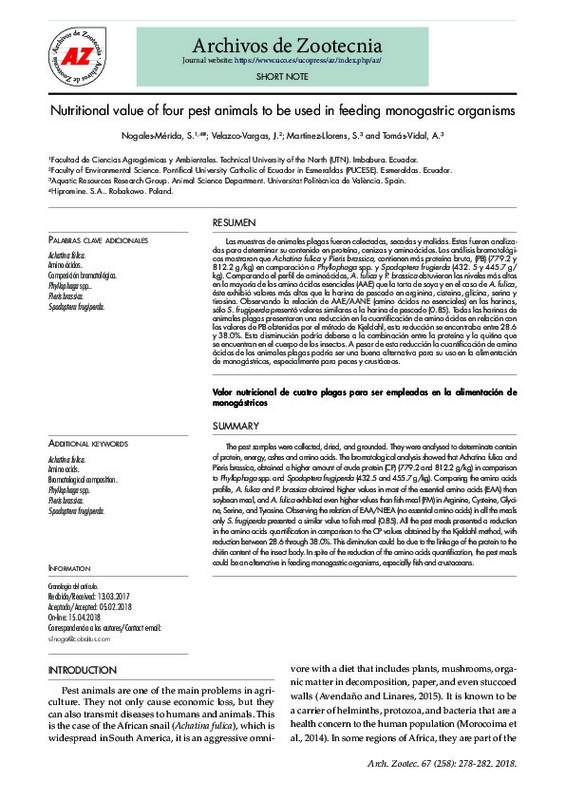JavaScript is disabled for your browser. Some features of this site may not work without it.
Buscar en RiuNet
Listar
Mi cuenta
Estadísticas
Ayuda RiuNet
Admin. UPV
Nutritional value of four pest animals to be used in feeding monogastric organisms
Mostrar el registro sencillo del ítem
Ficheros en el ítem
| dc.contributor.author | Nogales Mérida, Silvia
|
es_ES |
| dc.contributor.author | Velazco Vargas, Jorge Luis
|
es_ES |
| dc.contributor.author | Martínez-Llorens, Silvia
|
es_ES |
| dc.contributor.author | Tomas-Vidal, A.
|
es_ES |
| dc.date.accessioned | 2020-04-24T07:14:30Z | |
| dc.date.available | 2020-04-24T07:14:30Z | |
| dc.date.issued | 2018 | es_ES |
| dc.identifier.issn | 0004-0592 | es_ES |
| dc.identifier.uri | http://hdl.handle.net/10251/141462 | |
| dc.description.abstract | [ES] Las muestras de animales plagas fueron colectadas, secadas y molidas. Estas fueron analizadas para determinar su contenido en proteína, cenizas y aminoácidos. Los análisis bromatológicos mostraron que Achatina fulica y Pieris brassica, contienen más proteína bruta, (PB) (779.2 y 812.2 g/kg) en comparación a Phyllophaga spp. y Spodoptera frugierda (432. 5 y 445.7 g/ kg). Comparando el perfil de aminoácidos, A. fulica y P. brassica obtuvieron los niveles más altos en la mayoría de los amino ácidos esenciales (AAE) que la torta de soya y en el caso de A. fulica, éste exhibió valores más altos que la harina de pescado en arginina, cisteina, glicina, serina y tirosina. Observando la relación de AAE/AANE (amino ácidos no esenciales) en las harinas, sólo S. frugiperda presentó valores similares a la harina de pescado (0.85). Todas las harinas de animales plagas presentaron una reducción en la cuantificación de amino ácidos en relación con los valores de PB obtenidos por el método de Kjeldahl, esta reducción se encontraba entre 28.6 y 38.0%. Esta disminución podría deberse a la combinación entre la proteína y la quitina que se encuentran en el cuerpo de los insectos. A pesar de esta reducción la cuantificación de amino ácidos de los animales plagas podría ser una buena alternativa para su uso en la alimentación de monogástricos, especialmente para peces y crustáceos. | es_ES |
| dc.description.abstract | [EN] The pest samples were collected, dried, and grounded. They were analysed to determinate contain of protein, energy, ashes and amino acids. The bromatological analysis showed that Achatina fulica and Pieris brassica, obtained a higher amount of crude protein (CP) (779.2 and 812.2 g/kg) in comparison to Phyllophaga spp. and Spodoptera frugiperda (432.5 and 455.7 g/kg). Comparing the amino acids profile, A. fulica and P. brassica obtained higher values in most of the essential amino acids (EAA) than soybean meal, and A. fulica exhibited even higher values than fish meal (FM) in Arginine, Cysteine, Glycine, Serine, and Tyrosine. Observing the relation of EAA/NEEA (no essential amino acids) in all the meals only S. frugiperda presented a similar value to fish meal (0.85). All the pest meals presented a reduction in the amino acids quantification in comparison to the CP values obtained by the Kjeldahl method, with reduction between 28.6 through 38.0%. This diminution could be due to the linkage of the protein to the chitin content of the insect body. In spite of the reduction of the amino acids quantification, the pest meals could be an alternative in feeding monogastric organisms, especially fish and crustaceans. | es_ES |
| dc.description.sponsorship | To the Polytechnic University of Valencia for it support. | es_ES |
| dc.language | Inglés | es_ES |
| dc.publisher | Instituto de Salud Carlos III/BNCS/SciELO Espana | es_ES |
| dc.relation.ispartof | Archivos de Zootecnia | es_ES |
| dc.rights | Reconocimiento - Compartir igual (by-sa) | es_ES |
| dc.subject | Achatina fulica | es_ES |
| dc.subject | Amino acids | es_ES |
| dc.subject | Bromatological composition | es_ES |
| dc.subject | Phyllophaga spp | es_ES |
| dc.subject | Pieris brassica | es_ES |
| dc.subject | Spodoptera frugiperda. | es_ES |
| dc.subject.classification | PRODUCCION ANIMAL | es_ES |
| dc.title | Nutritional value of four pest animals to be used in feeding monogastric organisms | es_ES |
| dc.type | Artículo | es_ES |
| dc.identifier.doi | 10.21071/az.v67i258.3664 | es_ES |
| dc.rights.accessRights | Abierto | es_ES |
| dc.contributor.affiliation | Universitat Politècnica de València. Instituto de Ciencia y Tecnología Animal - Institut de Ciència i Tecnologia Animal | es_ES |
| dc.contributor.affiliation | Universitat Politècnica de València. Departamento de Ciencia Animal - Departament de Ciència Animal | es_ES |
| dc.description.bibliographicCitation | Nogales Mérida, S.; Velazco Vargas, JL.; Martínez-Llorens, S.; Tomas-Vidal, A. (2018). Nutritional value of four pest animals to be used in feeding monogastric organisms. Archivos de Zootecnia. 67(258):278-282. https://doi.org/10.21071/az.v67i258.3664 | es_ES |
| dc.description.accrualMethod | S | es_ES |
| dc.relation.publisherversion | https://doi.org/10.21071/az.v67i258.3664 | es_ES |
| dc.description.upvformatpinicio | 278 | es_ES |
| dc.description.upvformatpfin | 282 | es_ES |
| dc.type.version | info:eu-repo/semantics/publishedVersion | es_ES |
| dc.description.volume | 67 | es_ES |
| dc.description.issue | 258 | es_ES |
| dc.relation.pasarela | S\368542 | es_ES |
| dc.contributor.funder | Universitat Politècnica de València | es_ES |








